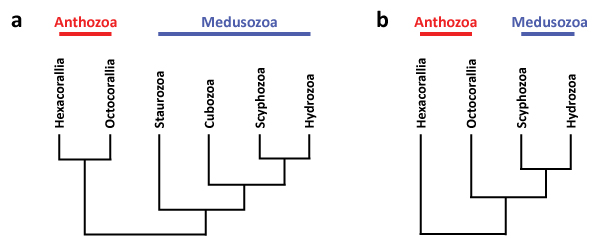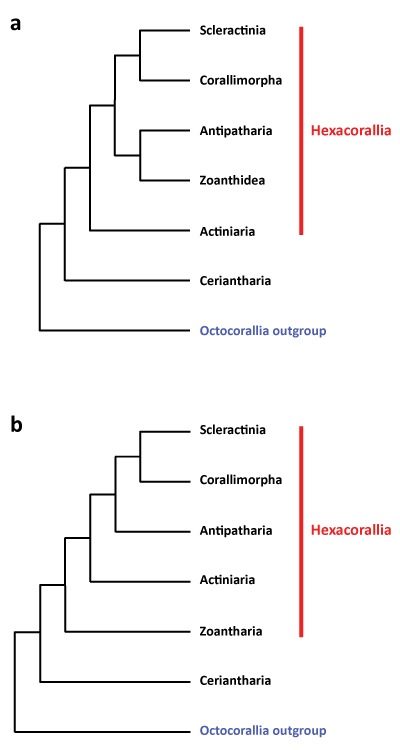Evolution & Systematics
Cnidaria is one the earliest branching metazoan lineages, the others being Porifera, Placozoa and Ctenophora. Determining the relationships between these groups is of the upmost importance in understanding early metazoan evolution. However, the relationships between these groups are poorly understood as phylogenies produced using different molecular characters yield different results. Despite differences in these phylogenies, Cnidaria is consistently positioned as the sister group to the Bilateria (Srivastava et al., 2008; Sperling et al.,2009; Hejnol et al., 2009; Srivastava et al. 2010; Erwin et al., 2011; Nosenko et al., 2013).

Figure 1: Hypothesised phylogenies of the Cnidaria based on (a) rRNA sequence data and (b) mitochondrial protein coding genes. Phylogenies based on rRNA data suggest anthozoan monophyly, while those based on mitochondrial protein coding data suggest anthozoan paraphyly. Adapted from figure 1 in Kayal et al. (2013).
Cnidaria is comprised of five classes: Anthozoa, Cubozoa, Hydrozoa, Scyphozoa and Stuarozoa. The latter four are grouped into the subphylum Medusozoa. Anthozoa is the most speciose class and includes the subclasses Hexacorallia and Octocorallia. The relationship between many cnidarian classes and orders is uncertain, as different methods of investigating phylogenies produce different results. For example, phylogenies based on rRNA and rDNA sequence data suggest that both Anthozoa and Medusozoa are monophyletic clades (France et al. 1996, Odorico and Miller, 1997; Berntson et al., 1999; Collins, 2002), whereas phylogenies based on mitochondrial DNA sequence data suggest paraphyly of Anthozoa, with Octocorallia being the sister group to Medusozoa (Parket et al., 2012; Kayal et al., 2013)(Figure 1). Phylogenies based on rRNA and mitochondrial DNA sequences both place Actiniaria, the order comprising sea anemonies, as branching basally off the hexacorallia stem (Berntson et al., 1999; Kayal et al., 2013)(Figure 2).

Figure 2: Hypothesised phylogenies of hexacorallian orders based on (a) nuclear 18S rDNA sequencese data and (b) mitochondrial protein coding genes. Both trees place Actiniaria (the order comprising sea anemones) on a basally branching position within the hexacorallian clade. (a) is adapted from figure 2 in Berntson et al. (1999), (b) is adapted from figure 2 in Kayal et al. (2013).
|